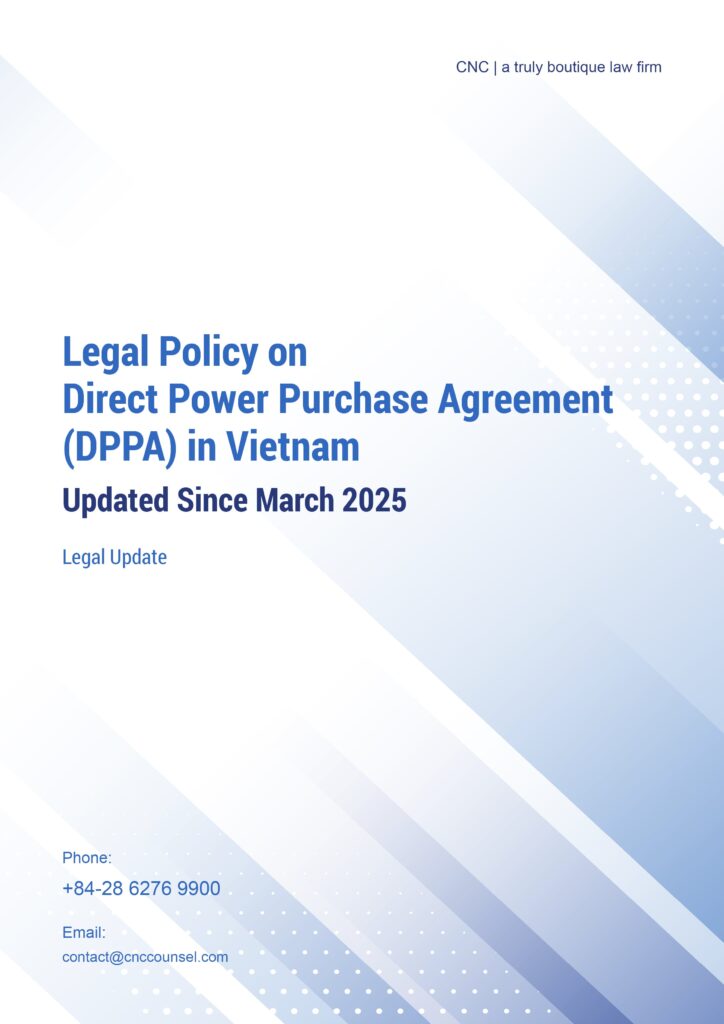Legal Policy on Direct Power Purchase Agreement (DPPA) in Vietnam: Updated Since March 2025
The new policy on Direct Power Purchase Agreement (“DPPA”) comes into force on 03 March 2025 via the new Decree No. 57/2025/ND-CP of the Government of Vietnam (“Decree 57”), following the ratification of the New Law on Electricity (2024).
Decree 57 replaces Decree No. 80/2024/ND-CP (“Decree 80”), which had taken in effect for a period of 8 months. CNC introduced Decree 80 in a previous Legal Update.
Through this article, CNC will update the noteworthy points on Decree 57.
Download PDF File here: Legal update_Legal Policy on Direct Power Purchase Agreement (DPPA) in Vietnam-Updated Since March 2025
Involved Parties
Decree 57 governs DPPA between Renewable Energy Generation Corporations (“RE GENCO”) and Large Power Consumers via private power lines or via the National Grid[1].
DPPA Program under Decree 57 shall involve the following parties:
- RE GENCOs;
- Large Power Consumers;
In case of DPPA via the National Grid, DPPA Program also includes:
- Vietnam Electricity Corporation (“EVN”);
- EVN Power Corporations under EVN (“EVNPC”);
- EVNPC Subsidiaries;
- Power retailers, including power retailers within Industrial Zones, Economic Zones, Economic Processing Zones, and similar areas (“IZ Power Retailer”).
(hereinafter collectively referred to as “Involved Parties”).
 Involved Parties in DPPA operation
Involved Parties in DPPA operation
RE GENCO
RE GENCOs shall own the power plant utilizing renewable energy sources.
However, under DPPA via the National Grid, Decree 57 only permits RE GENCO:
- Utilizing wind, solar, or biomass;
- Possessing a capacity of at least 10 MW;
- Connecting to the National Grid;
- Directly participating in the Vietnam Wholesale Electricity Market (“VWEM”).
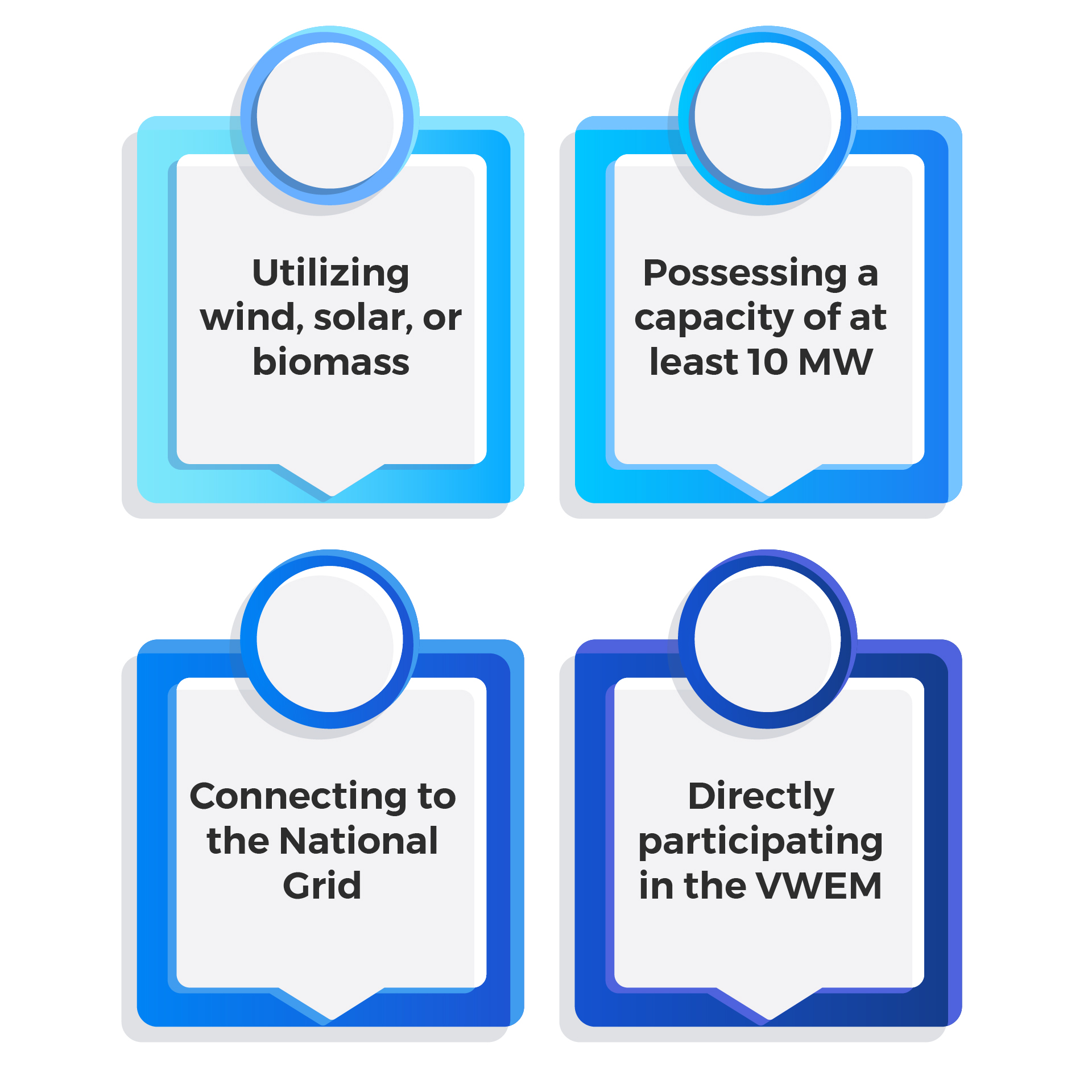
Requirements for RE GENCO operating DPPA via the National Grid
Large Power Consumer
Large Power Consumers shall be organizations/individuals who (i) buy electricity for consumption, and (ii) have large consumption capacity and output under the regulations of the Ministry of Industry and Trade (“MoIT”) [2].
Any Large Power Consumer operating DPPA via the National Grid shall also meet the following requirements[3]:
- Using electricity for production or providing electric vehicle charging services;
- Purchasing electricity from any EVNPC, EVNPC Subsidiary or power retailer;
- Connecting at a voltage level of at least 22 kV.
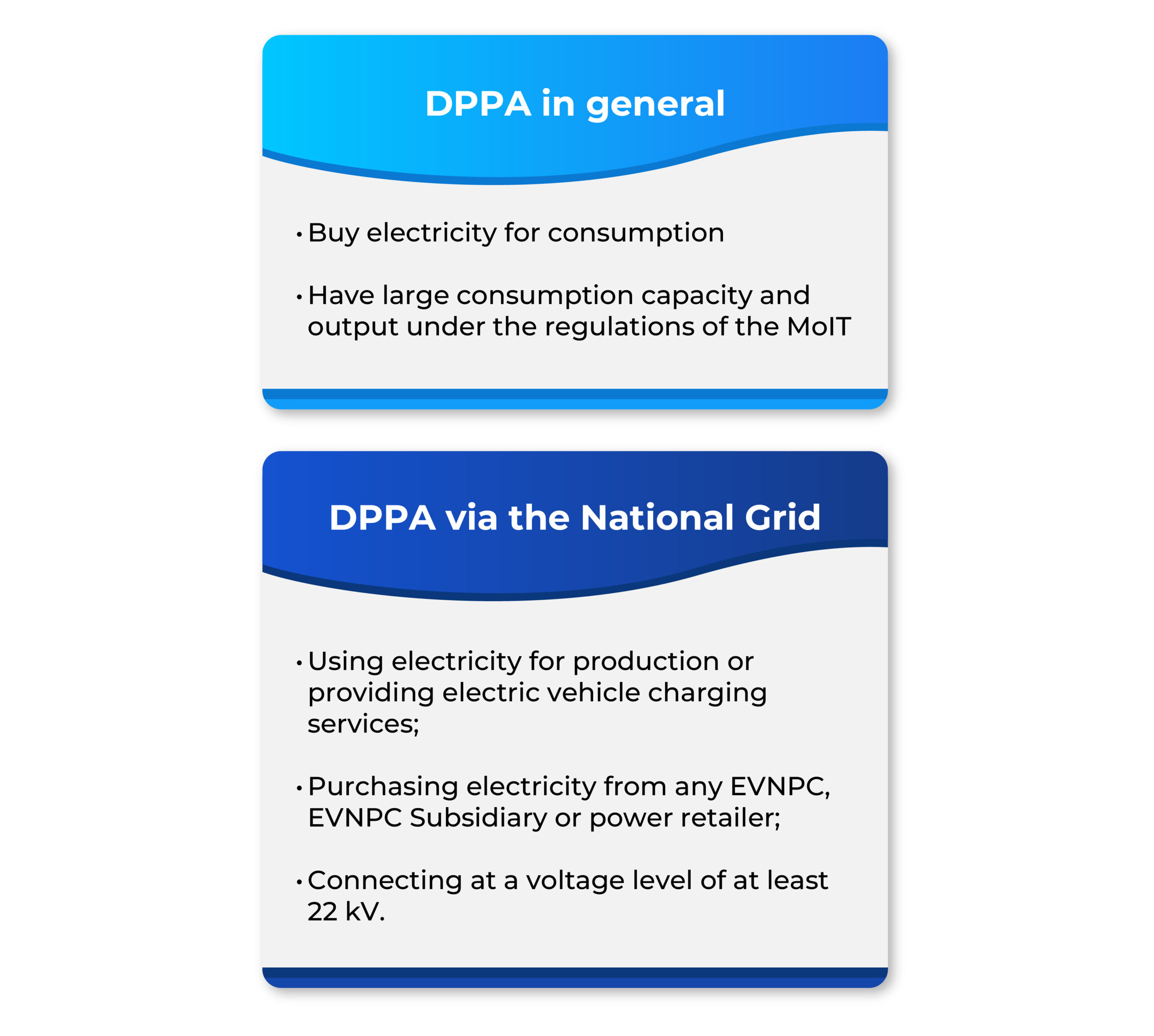
Requirements for Large Power Consumer operating DPPA
Under the latest MoIT regulations (effective 01 February 2025), the average electricity consumption output of Large Power Consumer shall be at least 200.000 kWh per month[4].
It should be noted that in case the average electricity consumption output calculated in a period from November of Year N-1 to October of Year N is lower than 200.000 kWh per month, the Large Power Consumer will not be entitled to operate DPPA in Year N+1[5].
However, Decree 57 provides that the average electricity consumption output shall be determined by the total electricity output purchased from an EVNPC or an EVNPC Subsidiary[6]. For Large Power Consumers operating DPPA via private power lines and having no connection to the National Grid, there is no method to determine consumption output for such Consumers.
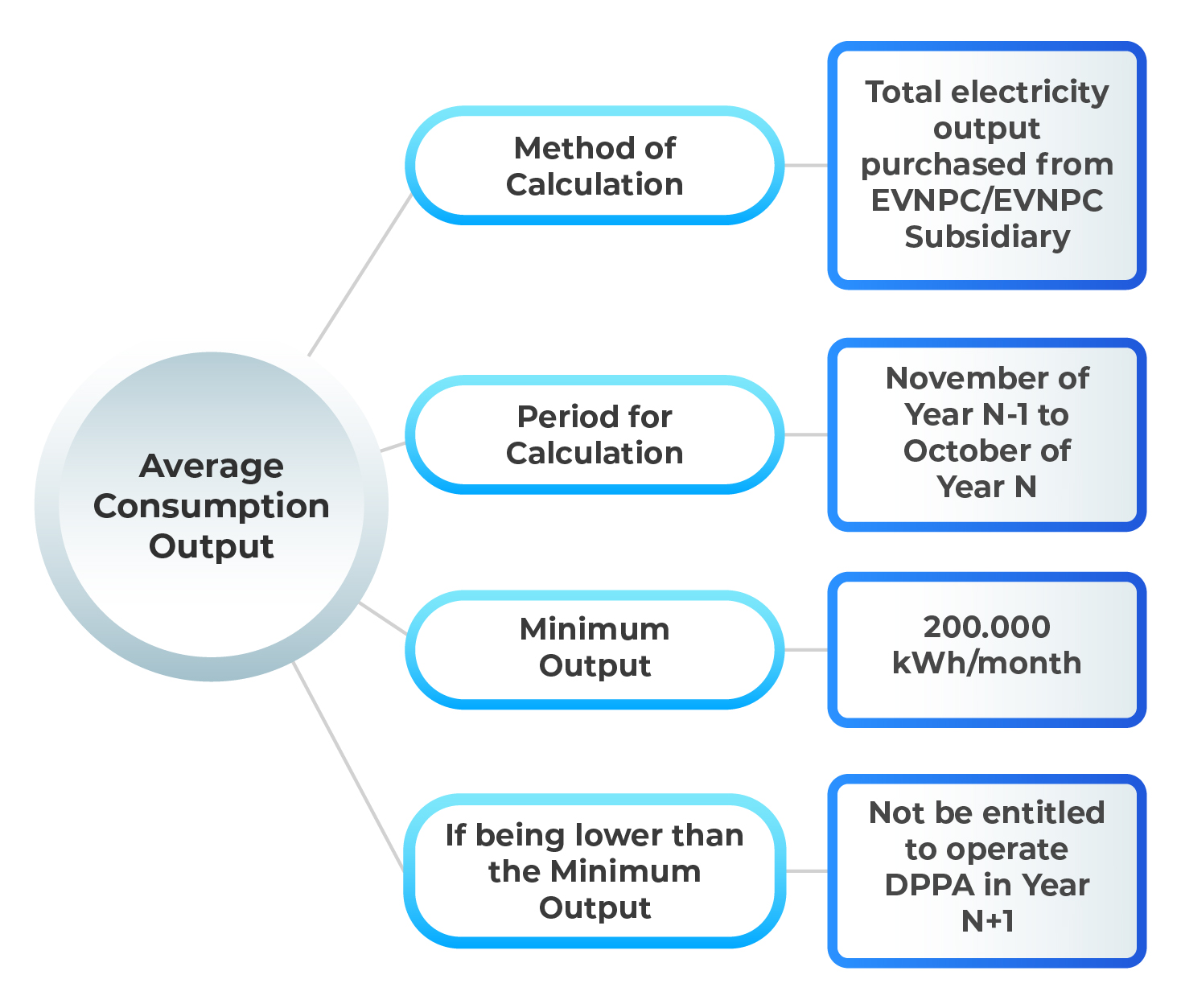
Requirements on the average consumption output for the Large Power Consumer under Decree 57 and Circular No.16/2025/TT-BCT
Policy on Excess Electricity Output Sales for Rooftop Solar Systems
Decree 57 governs the policy on excess electricity output sales for rooftop solar (“RTS”) systems under DPPA via private power lines, which was not mentioned in the previous Decree 80.
Accordingly, RE GENCO of RTS system (“RTS GENCO”) is entitled to sell excess output to:
- EVN or EVNPC or EVNPC Subsidiary; or
- IZ Power Retailer (if Large Power Consumer is located in Industrial Zone or any similar area).
For purchasers being EVN or its units, the excess electricity output for sales shall not exceed 20% of the actual generated output. In addition, the selling price of excess output shall be the average electricity market price in the preceding year, as announced by the National System Management Operator (“NSMO”)[7].
For purchasers being IZ Power Retailers, the output and selling price of excess electricity shall be determined by the agreement between RTS GENCO and IZ Power Retailers[8].
However, regardless of purchasers, the selling price of excess output shall not exceed the price ceiling for ground solar power, as announced by the MoIT[9].

Policy on Excess Electricity Output Sales for RTS Systems operating DPPA via private power lines
Furthermore, RE GENCO that is not RTS GENCO is entitled to sell excess output to EVN or EVNPC or EVNPC Subsidiary. The selling price of excess output shall not exceed the price ceiling for the relevant renewable energy source, as announced by the MoIT[10].
Procedures for operating DPPA via private power lines
Step 1: Licensing
RE GENCO (or Employer of Power Generation Project) shall conduct procedures on planning, investment, construction, power operation licenses for projects, works and grids to sell electricity directly to Large Power Consumer[11].
Step 2: Agreements
RE GENCO and Large Power Consumer shall discuss, negotiate, and conclude DPPA.
Decree 57 does not provide any standard template of DPPA under this DPPA Model. However, such DPPA shall comply with the related regulations and include the following key terms[12]:

Key terms of DPPA via private power lines
It should be noted that the electricity price shall not exceed the price ceiling for the relevant renewable energy source, as announced by the MoIT[13].
Step 3: Reports
There are 03 reports required for Large Power Consumer under DPPA via private power lines, including:
- Report on signing DPPA[14];
- Report on direct power purchase activity[15];
- Annual reports on DPPA operation[16].
The details of these reports shall be indicated as below:

03 reports required for Large Power Consumer under DPPA via private power lines
Procedures for operating DPPA via the National Grid
Decree 58 provides the procedures for operating DPPA via the National Grid. The details of such procedures are governed by the Guidance dated 31 December 2024 of NSMO on Registration for Operating DPPA between RE GENCO and Large Power Consumer (“DPPA Guidance”).
Accordingly, Large Power Consumer or authorized IZ Power Retailer (hereinafter referred to as “DPPA Client”) and RE GENCO will follow 04 steps: (i) Preparation of documents; (ii) Consensus on the intended DPPA schedule; (iii) Completing requirements for operating DPPA; (iv) Registration for operating DPPA.
Step 1: Preparation of documents
First of all, DPPA Client and RE GENCO shall prepare a power of attorney to authorize a unit (“Authorized Unit”) to submit an application for DPPA operation[17].
In addition, DPPA Client and RE GENCO shall also prepare the following documents:
- A written request for operating DPPA;
- A written agreement in principle on Forward Contract;
- A report on the current status of RE GENCO;
- Information on DPPA Client;
- A written confirmation of the agreed percentage (%) of allocated electricity output;
- Documents ensuring the compliance of RE GENCO with the regulations on planning.
For Large Power Consumer in industrial zone or any similar areas, and IZ Power Retailer, they also prepare these documents:
- A written agreement with EVNPC or EVNPC Subsidiary on the installation of electricity meters;
- A written agreement on the schedule for terminating the existing PPA between Large Power Consumer and IZ Power Retailer; OR
- A written agreement on modifying the existing PPA between Large Power Consumer and IZ Power Retailer to convert to DPPA and the power of attorney thereof;
DPPA Guidance provides templates of the above documents via Appendix II, which are illustrated as below:
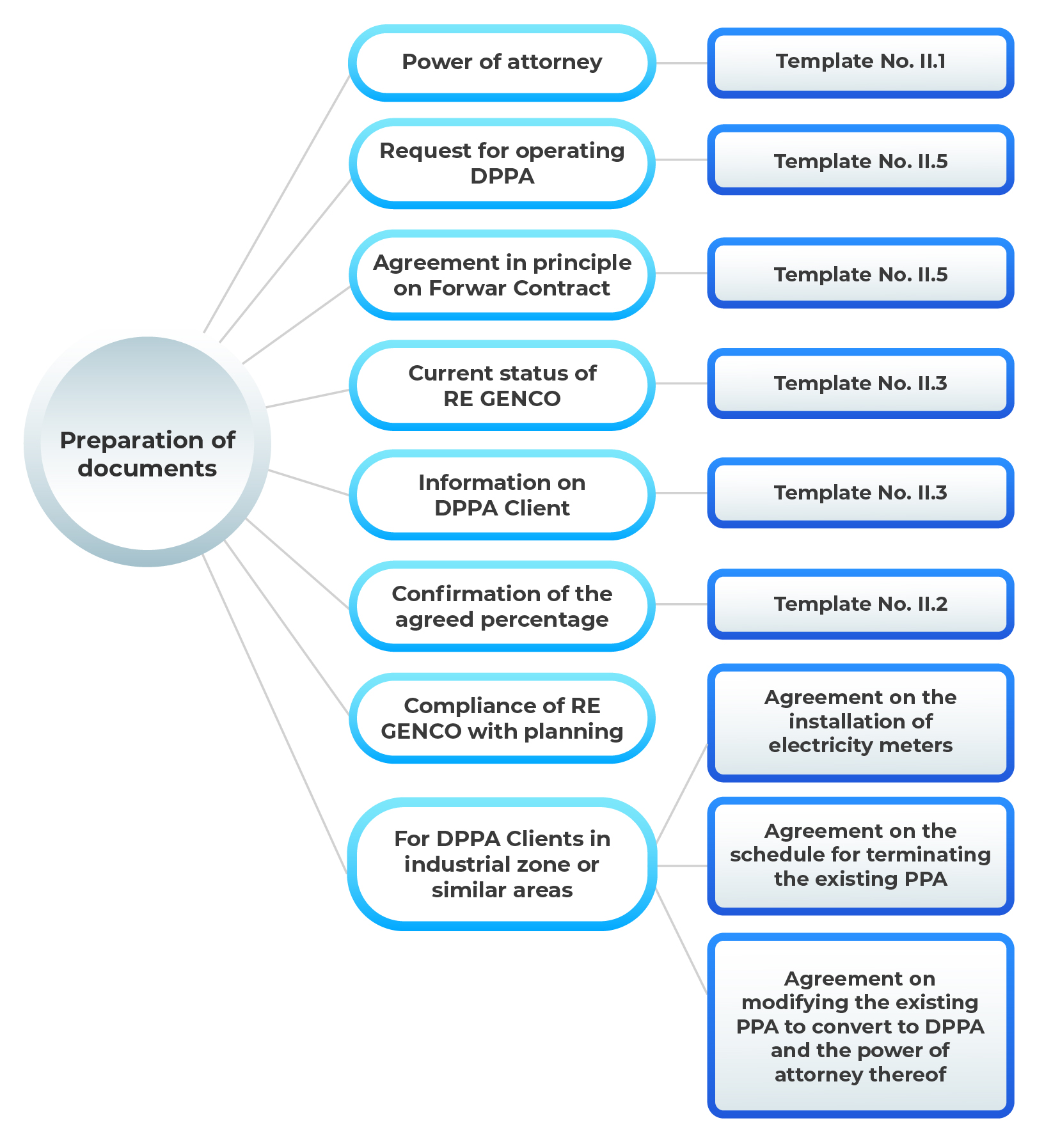
Preparation of documents for operating DPPA via the National Gridunder DPPA Guidance
Step 2: Consensus on the intended DPPA schedule
With the documents listed in Step 1, DPPA Client and RE GENCO shall submit them to NSMO for information on the intended DPPA schedule as follows[18]:
- Proposed date for signing PPA on the spot market between EVN and RE GENCO;
- Proposed date for converting the existing PPA between EVNPC/EVNPC Subsidiary/ IZ Power Retailer and Large Power Consumer;
- Proposed commencement date of DPPA.
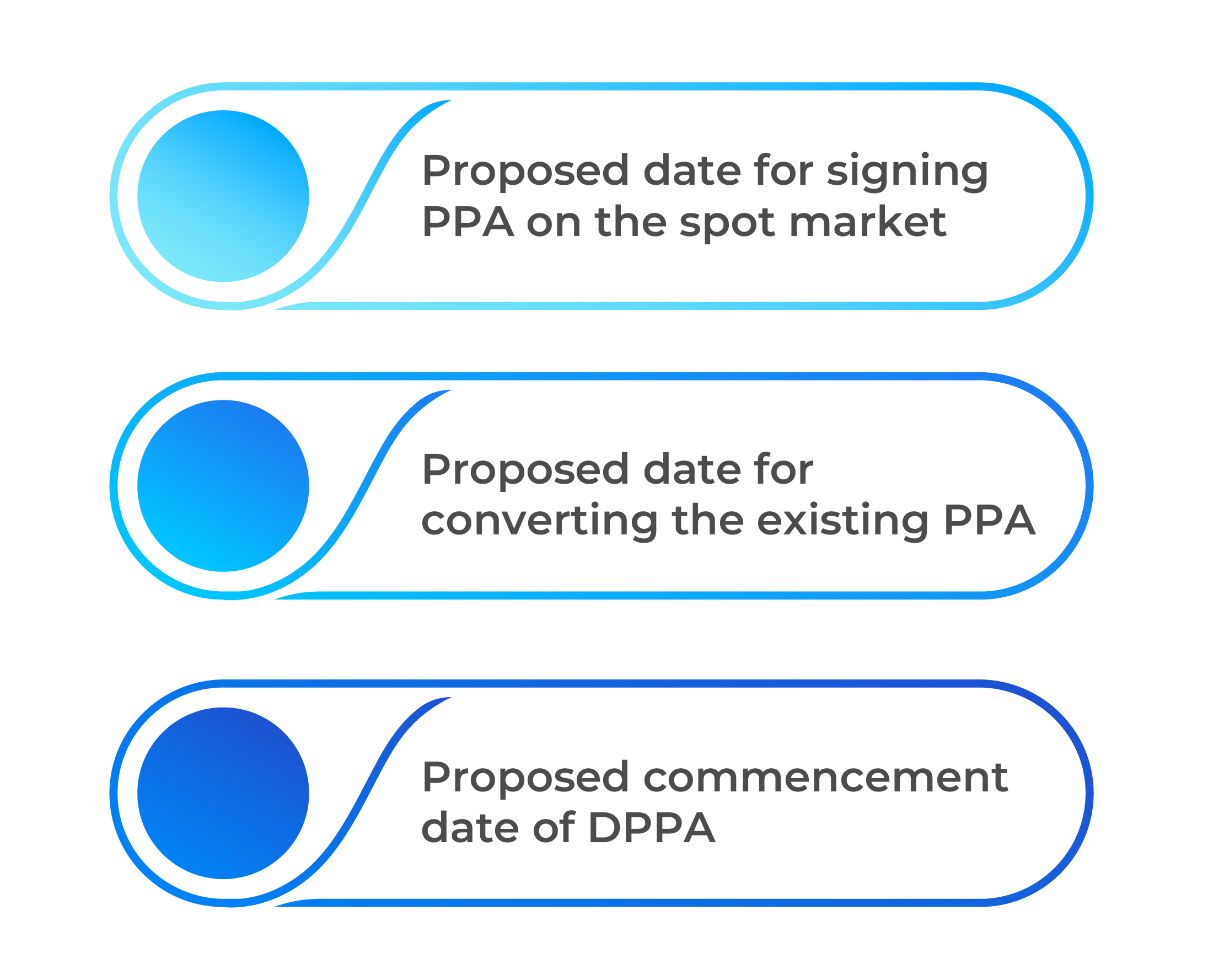
Information on the intended DPPA schedule given by under DPPA via the National Grid
Accordingly, the process for the consensus on the intended DPPA schedule shall be as follows[19]:
- Step 2.1: Authorized Unit submits the documents listed in Step 1 to NSMO;
- Step 2.2: NSMO responds to the sufficiency of the documents and gives opinions on the principle of metered output allocation, within 05 business days from the date of Step 2.1;
- Step 2.3: Authorized Unit resubmits the documents based on the supplement and the principle of metered output allocation as guided by NSMO (if any);
- Step 2.4: NSMO sends the completed dossiers to EVN/EVNPC/IZ Power Retailer (if any) to collect opinions within 05 business days from the date of Step 2.3;
- Step 2.5: EVN/EVNPC/IZ Power Retailer (if any) gives opinions to respond to NSMO within 05 business days from the date of Step 2.4;
- Step 2.6: NSMO gives a written response on the intended DPPA schedule to the Authorized Unit, within 05 business days from the date of Step 2.5.
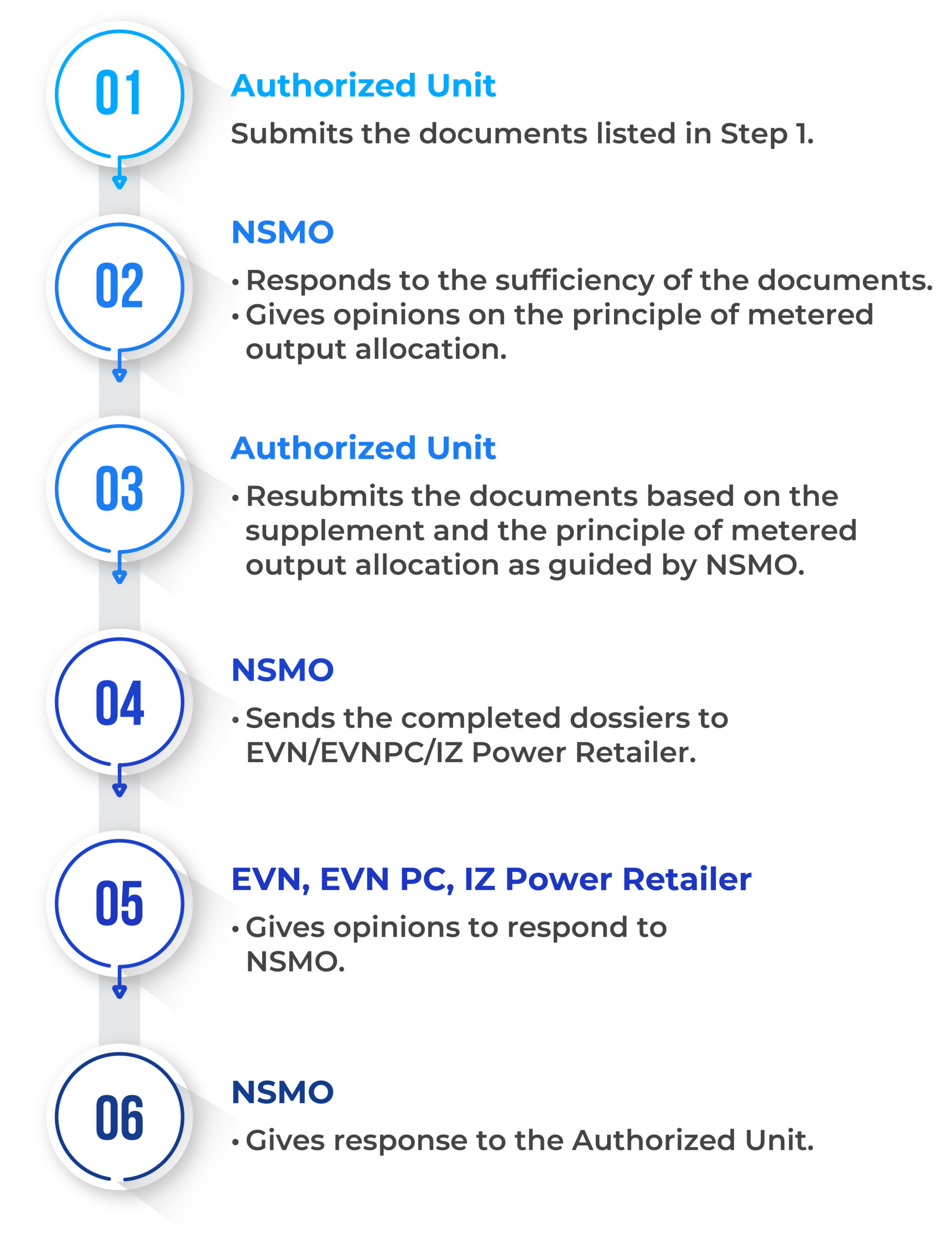
Process for the consensus on the intended DPPA schedule
Step 3: Completing requirements for operating DPPA
After receiving information on the intended DPPA schedule, DPPA Client and RE GENCO shall complete the requirements for operating DPPA as follows:
- Negotiating and signing relavant PPAs;
- DPPA Client implements the investment and acceptance of infrastructure facilities to comply with DPPA operation;
- RE GENCO complies with requirements for joining electricity market and operating DPPA.
In accordance, DPPA Client and RE GENCO shall collaborate with EVN/ EVNPC/ EVNPC Subsidiary/ IZ Power Retailer to negotiate and sign the following PPAs[20]:
- VWEM PPA on the spot market between EVN and RE GENCO;
- Retail PPA between DPPA Client and EVNPC/ EVNPC Subsidiary;
- Forward Contract (Contract for Differences) between RE GENCO and DPPA Client.

Relevant PPAs under DPPA via the National Grid
Additionally, DPPA Client shall collaborate with EVNPC or EVNPC Subsidiary to implement the investment and acceptance of infrastructure facilities to comply with requirements for operating DPPA, including metering systems and remote metering data collection system.[21]
For RE GENCO, RE GENCO also implement the investment and acceptance of infrastructure, and register to comply with requirements for joining electricity market and operating DPPA under regulation of MoIT on VWEM operation[22].
Step 4: Registration for DPPA
The Authorized Unit shall send the completed dossiers on DPPA operation to NSMO, after finishing Step 3.
Such dossiers include these following documents[23]:
- A written confirmation on completing the requirements for DPPA operation;
- Acceptances on infrastructure facilities of DPPA Client;
- Registration dossiers on joining the electricity market of RE GENCO;
- Copies of PPAs.

Dossiers on DPPA operation
After receiving the dossiers, NSMO shall give a written notice on the DPPA commencement date to RE GENCO and DPPA Client[24].
The operation of the DPPA program may be interrupted
One of many concerns about the DPPA program is the risk of policy misuse or profiteering due to the novelty of this policy in Vietnam. Decree 57 anticipates such risks by providing that the consequences of the act of “policy misuse or profiteering” in Article 27 shall be suspension or termination of the operation of the DPPA program (in case the consequences cannot be remedied) decided by the MoIT.
Furthermore, the operation of the DPPA program might also be suspended in the following situations: the MoIT suspends the electricity market; one of the PPAs is suspended or expires; the electricity consumption rate of the Consumer is below the minimum output under the regulations of the MoIT. The parties may resume the operation of the DPPA program in case the cause of suspension has been remedied or there are decisions by competent authorities.
Written by
 |
Senior Associate I Tran Pham Hoang Tung
Phone: (84) 901 334 192 Email: tung.tran@cnccounsel.com |
 |
Legal Assistant I Pham Nguyen Tan Trung
Phone: (84) 028 6276 9900 Email: trung.pham@cnccounsel.com |
[1] See Article 2, Decree 57.
[2] See Article 3.9 and 3.10, Decree 57.
[3] See Article 2.2(b), Decree 57.
[4] See Article 3.50, Circular No. 16/2025/TT-BCT of Minister of Industry and Trade dated 01 February 2025 regulating VWEM operation.
[5] See Article 5.2(b) and 27.1(a), Decree 57.
[6] See Article 5.2, Decree 57.
[7] See Article 6.3, Decree 57.
[8] See Article 6.4, Decree 57.
[9] See Article 6.3 and 6.4, Decree 57.
[10] See Article 6.2, Decree 57.
[11] See Article 25.1, Decree 57.
[12] See Article 6.1 and 25.2, Decree 57.
[13] See Article 6.1(b), Decree 57.
[14] See Article 25.3 and 25.4, Decree 57.
[15] See Article 28.1(a), Decree 57.
[16] See Article 28.1(b), Decree 57.
[17] See Article 10, DPPA Guidance.
[18] See Article 16.3, DPPA Guidance.
[19] See Article 16, DPPA Guidance.
[20] See Article 17, DPPA Guidance.
[21] See Article 18, DPPA Guidance.
[22] See Article 19, DPPA Guidance.
[23] See Article 20, DPPA Guidance.
[24] See Article 21, DPPA Guidance.



